|
Posted: 9/26/2010 9:20:12 PM EDT
[Last Edit: Molon]
MK318 Mod 0 (Federal T556TNB1)
 One version of MK318 Mod 0 that is now available to the general public is being sold as Federal "white box" T556TNB1. The SOST projectile loaded in the MK318 Mod 0 cartridge has a nominal weight of 62 grains and a nominal length of 0.87”. It is constructed with a copper base and a small, non-bonded lead core in the ogive section of the bullet. Due to this higher copper to lead ratio, the MK318 Mod 0 projectile is longer than a traditional copper jacketed/lead core projectile of the same weight, but is still slightly shorter than an M855 projectile.   While it is often stated that the SOST projectile used in MK318 Mod 0 is similar to the Federal Trophy Bonded Bear Claw, the form of the SOST projectile more closely resembles that of Federal’s Trophy Bonded Tip projectile (without the tip of course.) As previously mentioned, the MK318 projectile does not have a bonded core.   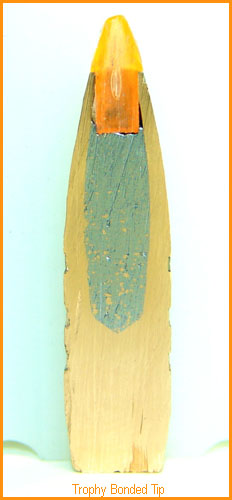 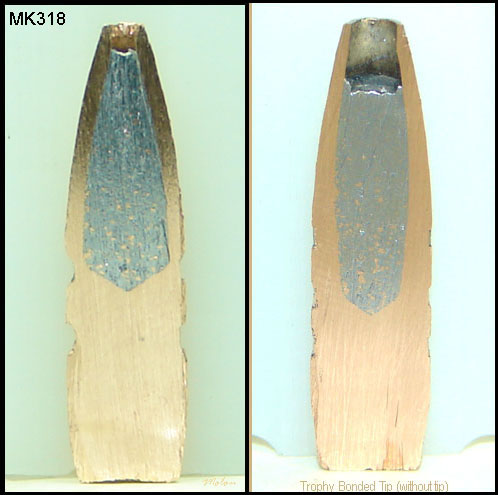 The loaded MK318 Mod 0 cartridge has a nominal OAL of 2.20". The projectile does not have a cannelure per se, but the case mouth is crimped into the top relief band. The cartridge is sealed at the case mouth, however not with the asphalt sealant typically found on military ammunition. The primers are sealed and crimped. The casehead is stamped "FC 10". The cartridge is charged with ball powder. 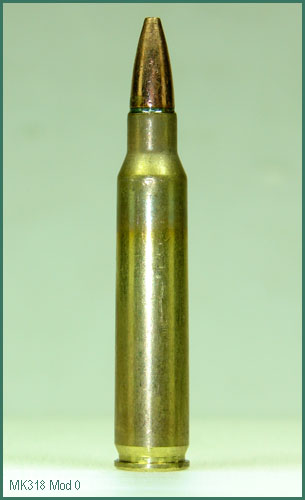  A typical copper jacketed/lead core FMJ bullet will have a specific gravity of approximately 10.2. Due to its higher copper to lead ratio construction, the MK318 Mod 0 projectile has a lower specific gravity. When fired from typical AR-15 barrel lengths with a 1:9” twist rate, MK318 Mod 0 will have a gyroscopic stability factor of approximately 1.3. 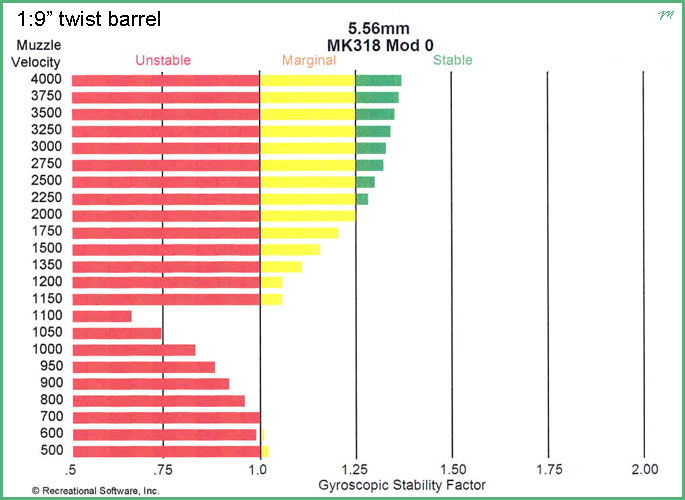 When fired from typical length barrels with a 1:7" twist rate, MK318 Mod O will have a gyroscopic stability factor of approximately 2.2. 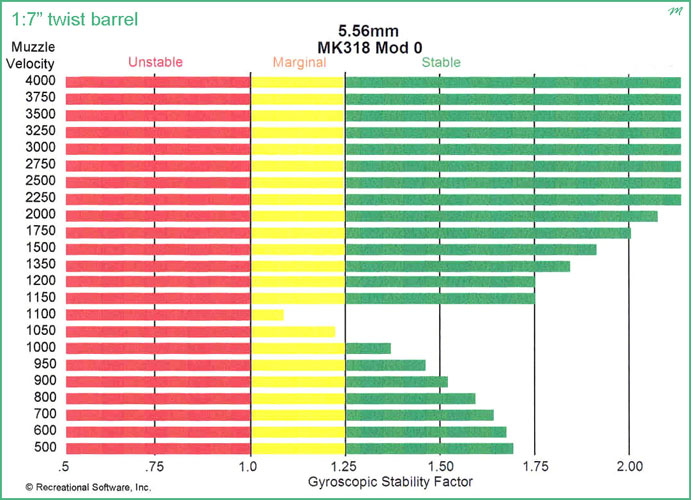 MK318 Mod 0 Chronograph Data Chronographing of the Mk318 Mod 0 ammunition was conducted using an Oehler 35-P chronograph with “proof screen” technology. All velocities listed below are muzzle velocities as calculated from the instrumental velocities using Oehler’s Ballistic Explorer software program. All strings of fire consisted of 10 rounds each.   Each round was single-loaded and cycled into the chamber from a magazine fitted with a single-load follower. The bolt locked-back after each shot allowing the chamber to cool in between each shot. This technique was used to mitigate the possible influence of “chamber-soak” on velocity data. Each new shot was fired in a consistent manner after hitting the bolt release. Atmospheric conditions were monitored and recorded using a Kestrel 4000 Pocket Weather Tracker.  Atmospheric conditions: Temperature: 75 degrees F. Humidity: 47%. Barometric pressure: 29.97 inches of Hg Elevation: 950 feet above sea level Two different barrel lengths were used in obtaining velocity data; a 14.5” Colt M4A1 barrel and a 20” Colt M16A2 barrel. Both barrels have NATO chambers, are chrome lined and have 1:7” twist rates. Both barrels have low round-counts on them. M4A1 barrel.  M16A2 barrel.  For comparison, the MK318 Mod 0 ammunition was fired in sequence with two different brands of 62 grain M855 ammunition. The firing order for both barrels was as follows: 1.A 10-shot string of Winchester Ranger M855 2.A 10-shot string of MK318 Mod 0 3.A 10-shot string of IMI M855 Finally, the data: 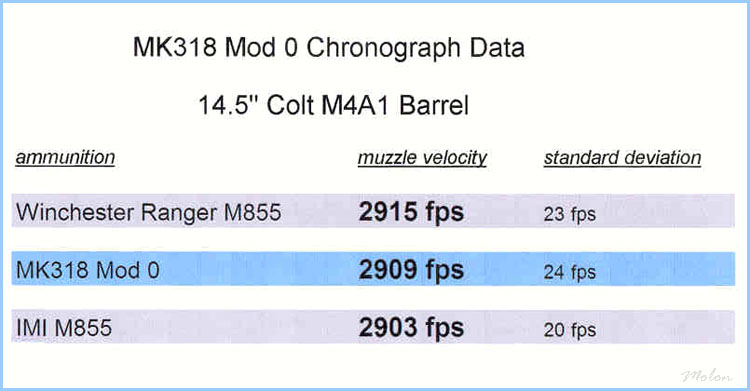  The Crane Warfare Centers' publication, “U.S. Navy Small Arms Ammunition Advancements” reported that MK318 was “optimized” for the MK 16 with a 14 inch barrel and claimed it has a velocity of 2925 fps at 15 feet from the muzzle (presumably from said 14 inch barrel.) The lot of Federal T556TNB1 (MK318 Mod 0) that I chronographed from the Colt 14.5” M4A1 barrel would have a velocity of approximately 2889 fps at 15 feet from the muzzle (at standard atmospheric conditions.) Accuracy Evaluation of MK318 Mod 0 An accuracy (technically, precision) evaluation of the MK318 Mod 0 ammunition was performed following my usual protocol. This accuracy evaluation used statistically significant shot-group sizes and every single shot in a fired group was included in the measurements. There was absolutely no use of any Group Reduction Techniques (e.g. fliers, target movement, Butterfly Shots). The shooting set-up will be described in detail below. As many of the significant variables as was practicable were controlled for. Also, a "control group" was fired from each barrel used in the evaluation using match-grade, hand-loaded ammunition; in order to demonstrate the capability of the barrel. Pictures of shot-groups are posted for documentation. All shooting was conducted from a concrete bench-rest from a distance of 100 yards (confirmed with a laser rangefinder.) The barrels used in the evaluation were free-floated. The free-float handguards of the rifles rested in a Sinclair Windage Benchrest, while the stock of the rifles rested in a Protektor bunny-ear rear bag. Sighting was accomplished via a Leupold VARI-X III set at 25X magnification and adjusted to be parallax-free at 100 yards. A mirage shade was attached to the objective-bell of the scope. Wind conditions on the shooting range were continuously monitored using a Wind Probe. The set-up was very similar to that pictured below. The Wind Probe.  In order to establish a working baseline for the intrinsic accuracy of the 62 grain SOST projectile itself, when fired from a semi-automatic AR-15, I worked-up a SAAMI pressure hand-load with pulled MK318 bullets and fired a 10-shot group of that load from a Krieger barreled AR-15 from a distance of 100 yards. The Krieger barrel has a 1:7.7” twist rate. Prior to firing the 62 grain SOST hand-load, I fired a 10-shot control group consisting of hand-loaded 62 grain Berger hollow points. The extreme spread for the control group measured 0.66”. 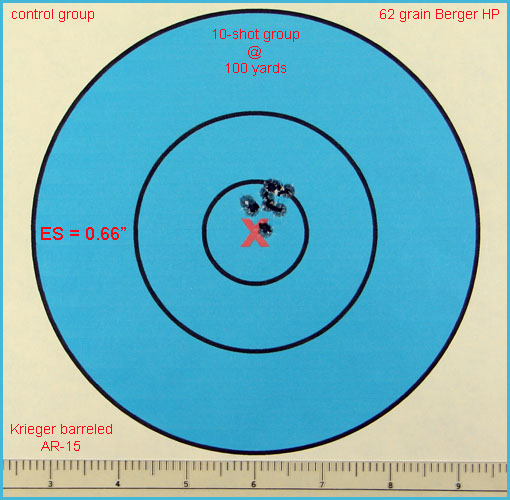 The extreme spread of the 10-shot group of the 62 grain SOST hand-load measured 1.9”.  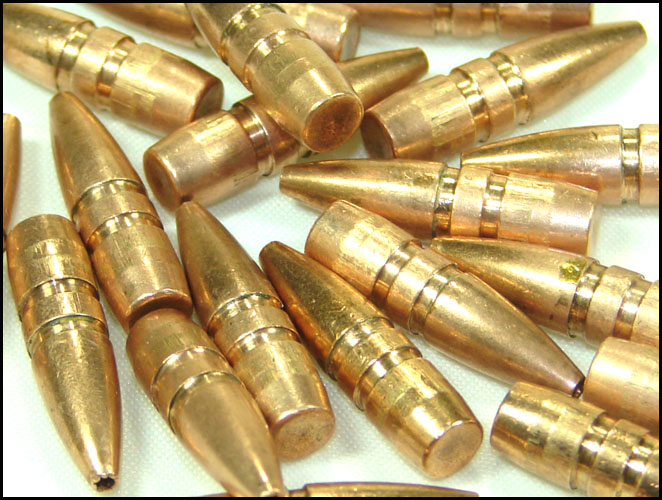 Since MK318 Mod 0 is intended for use as a combat round, I used AR-15s with chrome-lined, NATO chambered barrels for this accuracy evaluation, as it most likely that these are the types of barrels that this ammunition will most commonly be fired from. It is sometimes possible to obtain slightly better accuracy from mil-spec/NATO pressure loads by firing them from an AR-15 that has a stainless steel match-grade barrel with a hybrid chamber such as the Noveske NMmod0 chamber or the Wylde chamber for examples; but you're not going to make a silk purse out of a sow’s ear. As previously mentioned, it is reported that MK318 was “optimized” for a 14 inch barrel, so it seemed only fitting to evaluate MK318 from a similar length barrel. The first test vehicle used in this accuracy evaluation was a 14.5” Colt M4A1 barrel. The barrel was free-floated with a Daniel Defense Omega rail. (I was not able to use the mirage-shade with this barrel, due to the original standard front sight base on it.) A previous accuracy evaluation of this M4A1 barrel demonstrated that this barrel is capable of excellent accuracy for a chrome-lined, NATO chambered barrel. That evaluation can be viewed here: The Colt M4A1 SOCOM Barrel   A control group fired from the M4A1 barrel using hand-loaded 62 grain Berger hollow-point projectiles had an extreme spread of 1.13”.  Three 10-shot groups of the MK318 were fired from the Colt M4A1 barrel from the previously described bench-rest set-up. The extreme spreads of those groups measured: 2.91” 3.22” 2.70” for a 10-shot group average extreme spread of 2.94”. The three 10-shot groups were over-layed on each other using RSI Shooting Lab to form a 30-shot composite group. The mean radius of this composite group was 1.02”. (For those of you not familiar with the mean radius, I've posted an explanation of it in the third post of this thread.) The smallest 10-shot group of MK318 fired from the Colt M4A1 barrel is shown below. 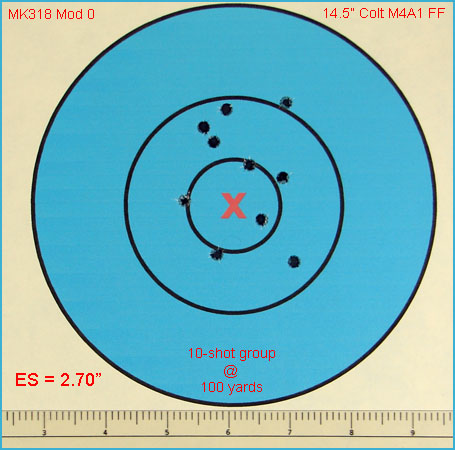 The next test vehicle was a 16” Colt HBAR with a 1:9” twist. This is the same barrel found on the Colt 6721 Tactical Carbine. This barrel is one of the most accurate “out of the box” chrome-lined, NATO chambered barrels that I’ve evaluated. The barrel was free-floated with a LaRue Tactical handguard.  A 10-shot group from this barrel fired using hand-loaded Sierra 52 grain MatchKings had an extreme spread of 0.98”. 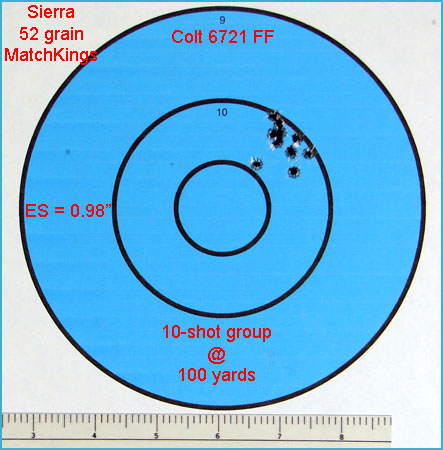 Three 10-shot groups of the MK318 fired from the Colt 6721 barrel produced the following extreme spreads: 2.98” 2.85” 2.89” for a 10-shot group average extreme spread of 2.91”. These three groups were also over-layed on each other to produce a 30-shot composite group with a mean radius of 0.82”. The smallest 10-shot group of MK318 fired from the Colt 6721 barrel . . .  The third barrel used to evaluate the accuracy of MK318 was a 20” Colt HBAR with a 1:7” twist, chrome-lining and a NATO chamber. The barrel is free-floated with a PRI handguard.  A 10-shot group from this barrel fired using hand-loaded 55 grain Sierra BlitzKings had an extreme spread of 1.18”.  Three 10-shot groups of the MK318 fired from the 20” HBAR had extreme spreads of: 2.70” 2.49” 3.24” for a 10-shot group average extreme spread of 2.81”. As before, the three 10-shot groups were over-layed on each other to form a 30-shot composite group that produced a mean radius of 0.91”. The smallest 10-shot group of MK318 fired from the 20” HBAR . . .  A summary of the results from this evaluation are shown below.  Lastly, for the Internet Commandos in our viewing audience, here’s a pic of a sub-MOA group of the MK318 fired from the 16” Colt HBAR from 100 yards; a cherry-picked 3-shot group that is. .... |
|
|
All that is necessary for Trolls to flourish, is for good men to do nothing.
In God We Trust. Everyone else needs to post data. |
|
A PRIMER ON THE MEAN RADIUS
The mean radius is a method of measurement of the radial dispersion of shot-groups that takes into account every shot in the group. It provides a more useful analysis of the consistency of ammunition and firearms than the commonly used method of extreme spread. Mean radius as defined in Hatcher's Notebook “is the average distance of all the shots from the center of the group. It is usually about one third the group diameter (extreme spread)” for 10-shot groups. The ratio of large sample sizes is actually closer to 3.2 x the mean radius = the extreme spread for 10-shot groups, depending on the sample size and the morphology of the particular groups sampled. To obtain the mean radius of a shot-group, measure the heights of all shots above the lowest shot in the group. Average these measurements. The result is the height of the center of the group above the lowest shot. Then in the same way, get the horizontal distance of the center from the shot farthest to the left. These two measurements will locate the group center. Now measure the distance of each shot from this center. The average of these measures is the mean radius. Once you get the hang of measuring groups using the mean radius it becomes very simple to do. While being very simple to do, it is also very time consuming. Modern software programs such as RSI Shooting Lab and On Target make determining the mean radius a snap. The picture below is a screen capture from RSI Shooting Lab. The red cross is the center of the group (a little high and right of the aiming point). The long red line shows the two shots forming the extreme spread or group size. The yellow line from the red cross to one of the shots is a radius. Measure all the radii and take the average to obtain the mean radius. Mean Radius Demonstration Let’s say you fired a 5-shot group from 100 yards and the resulting target looks like this. (The X-ring measures 1.5” and the 10-ring measures 3.5”.) The extreme spread of the group measures 2.83”, but we want to find the mean radius (or average group radius.) In order to find the mean radius we must first find the center of the group. By “eye-balling” the target most people would see that the group is centered to the left of the “X-ring” and probably a little high, but we need to find the exact location of the center of the group. Locating the Center of the Group The first step in finding the center of the group is to find the lowest shot of the group and draw a horizontal line through the center of that shot. Next, find the left-most shot of the group and draw a vertical line through the center of that shot. Now measure the distance from the horizontal line to the other four shots of the group that are above that line. Add those numbers together and divide by the total number of shots in the group (5). 2.50” + 1.03” + 2.01” + 1.30” = 6.84” Divide by 5 to get 1.37”. This number is the elevation component of the center of the group. Next we need to find the windage component of the center of the group. From the vertical line, measure the distance to the other four shots of the group that are to the right of the line. Add those numbers together and again divide by the total number of shots in the group (5). 1.76” + 2.54” + 0.45” + 1.19” = 5.94” Divide by 5 to get 1.19” This is the windage component of the center of the group. Finding the windage and elevation components of the center of the group is the most difficult part of this process. Once that is done the rest of the process is a piece of cake. Using the windage and elevation components, locate the position on the target that is 1.37” (elevation component) above the horizontal line and 1.19” (windage component) to the right of the vertical line. This location is the center of the group! Determining the Mean Radius Now that we have located the position of the center of the group, the first step in determining the mean radius is to measure the distance from the center of the group to the center of one of the shots. This line is a single “radius”. Now measure the distance from the center of the group to the center of each of the rest of the shots in the group. Add the measurements of all the radii together and then divide by the total number of shots in the group (5). 0.85” + 1.35” + 1.38” + 0.84” + 1.61” = 6.03” Divide by 5 to get 1.21”. This is the mean radius (or average group radius) of the group! Using the mean radius measurement to scribe a circle around the center of the group gives you a graphic representation of the mean radius. This shows the average accuracy of all the shots in the group. This demonstrates why the mean radius is much more useful than the extreme spread in evaluating the radial dispersion of our rifles and ammunition. The table below will give you an idea of the relationship between the mean radius and extreme spread for 10-shot groups. Here are some interesting quotes on the subject from old issues of American Rifleman. “Mean radius is the mean distance of bullet impacts from center of the test group. It is used in government ammunition acceptance because it takes account of every shot and comes close to maximizing the test information. While there is no exact relationship between this measure and the simpler and more convenient group diameter, the 10-shot group diameter averages slightly over 3 times the mean radius.” "These examples illustrate the sensitiveness of the extreme spread to number of shots in the group. Indeed, as the table indicates, the measures made to only the outside shots of the group, e.g. the extreme spread, are very sensitive to number of shots, while the measures made to all the shots, e.g. the mean radius are far less so. It may be added that the latter measures are also less variable in their representation of the group; they are more efficient. This explains why the target testing of U.S. military rifle ammunition is by mean radius." |
|
|
All that is necessary for Trolls to flourish, is for good men to do nothing.
In God We Trust. Everyone else needs to post data. |
|
.....
|
|
|
All that is necessary for Trolls to flourish, is for good men to do nothing.
In God We Trust. Everyone else needs to post data. |
|
NICE!
WHere did you get SOST projectiles to hand load? I am impressed by the group from the 16" rifle, while it is a "large" group, im amazed how tightly 8 of the rounds grouped, where in the other tthe 14.5" rifle seemed like a shotgun pattern. As for your handloaded ones, did you aaply a crimp? It seems ike you have some verticle stringing which, atleast for me, can be fixed with a very light crimp. |
|
|
|
|
So who's making the bullets? Barnes?
|
|
|
RIP, HoustonHusker.
|
|
Glad to see that you're still here.
|
|
|
What is your budget, and what do you want to do with the rifle? These are the questions you must answer before purchasing anything.
|
|
Originally Posted By Gone_Shootin:
So who's making the bullets? Barnes? Federal makes the bullets. Note the comparison to the TBBC tipped bullet from Federal. I am still not sure why there is so much interest on the civilian side regarding this ammo. LE, and civilians have had access to 60gr NP, Federal Tactical bonded (TBBC), and Barnes for quite a while, and now Speer Gold Dot, Fusion, and Hornady barrier. Without the imposed limitations set for th by JAG civilians can use any of these with no issues. Most civilians have no need for shooting into cars, and through windshields, and would still probably be better served with either .223, or 5.56 pressure heavy 75/77gr OTMs. Molon Thanks for the report, and the excelent explaination of mean radius. I think I will use that for evaluating my targets next time. By the way what software are you using for stability, and targets? |
|
|
|
|
As usual, a fantastic report. Thank you !
|
|
|
|
|
Now THIS is what everyone's been waiting for!
Nice writeup as always. 
|
|
|
|
|
Seems like the accuracy of the new round isn't up to what it's supposed to be capable of. Any comments on that, Molon? I wonder if these lots are rejects for accuracy reasons?
|
|
|
|
|
Originally Posted By bernieb99:
Originally Posted By Gone_Shootin:
So who's making the bullets? Barnes? I am still not sure why there is so much interest on the civilian side regarding this ammo. LE, and civilians have had access to 60gr NP, Federal Tactical bonded (TBBC), and Barnes for quite a while, and now Speer Gold Dot, Fusion, and Hornady barrier. Molon Thanks for the report, and the excelent explaination of mean radius. I think I will use that for evaluating my targets next time. By the way what software are you using for stability, and targets? Gold Dots: seem to be LEO only, and backordered/hard to obtain. Fusions: not widely available. TBBC: I haven't found any for sale online Hornady barrier (8125n) seems to be unobtainium. Putting aside the issue of civvies "needing" to be able to shoot through barriers, which we can debate endlessly, there aren't many barrier blind loads that a civvie can actually buy w/o tons of searching or LEO-only hassle. So the Mk 318 ammo seems to fit the bill, but from what I'm seeing, the accuracy isn't up to what I was expecting. I seem to recall that the claimed accuracy was on the order of 1.5 moa or so, wasn't it? |
|
|
|
|
Absolutely fascinating, top-notch report.
I'm sort of surprised by the groups you shot - I was expecting that load to do much better, as the projectiles ought to be capable of better.....hmm. |
|
|
...But his word was in mine heart as a burning fire shut up in my bones, and I was weary with forbearing, and I could not stay...All my familiars watched for my halting...But the LORD is with me as a mighty terrible one...
Jeremiah 20 9-11 |
|
Originally Posted By arowneragain:
Absolutely fascinating, top-notch report. I'm sort of surprised by the groups you shot - I was expecting that load to do much better, as the projectiles ought to be capable of better.....hmm. I'm thinking they sacrificed accurracy for velocity. Molon how did you get the bare projectiles? |
|
|
|
|
Originally Posted By InfiniteGrim:
Originally Posted By arowneragain:
Absolutely fascinating, top-notch report. I'm sort of surprised by the groups you shot - I was expecting that load to do much better, as the projectiles ought to be capable of better.....hmm. I'm thinking they sacrificed accurracy for velocity. Molon how did you get the bare projectiles? I'm guessing he pulled them himself - I worked-up a SAAMI pressure hand-load with pulled MK318 bullets
Nice test as always Molon and thanks for sharing. I know you go to great expense to do these tests and I think we all appreciate your hard work  . .
|
|
|
Μολὼν λαβέ
"We'll keep clinging to our Constitution and our guns and religion, and you can keep the change." - Sarah Palin |
|
GREAT POST tagged for review later
|
|
|
Ranger Airborne 1st Batt 75Inf NRA ENDOWMENT MEMBER
Army Ranger, Firefighter/Paramedic and born in America and believes in the Constitution, in the Government's eye's I'm a Terrorist. What has this country come to???? |
|
Marked as "Do not archive". I will copy-and-paste your post into the heavy OTM post in the ammo review as well.
|
|
|
Daddy loves you. Now go away.
|
|
Originally Posted By billclo:
Seems like the accuracy of the new round isn't up to what it's supposed to be capable of. Any comments on that, Molon? I wonder if these lots are rejects for accuracy reasons? I was a bit surprised even the handloaded 318 showed such a spread, especially as they're marketed as OTM "Open Tip, Match" though that's likely to be for JAG reasons Charge Molon? I only saw "SAAMI pressure spec". A given number? If so are you thinking of working up a load to evaluate the best possible group? |
|
|
Psalm 91:7 A thousand may fall at your side, ten thousand at your right hand, but it will not come near you. [img]icon_smile.gif[/img]
<font color=blue>http://danpass.blogspot.com</font id=blue |
|
Thanks for all of the information and hard work Molon.
Did you have any issues with copper fouling firing exclusively the M318 or in combination with another bullet type in the same barrel? |
|
|
|
|
Buckeye Firearms Association Leaders Volunteer Co.
|
Thank you sir, very well done as always!
|
|
"If people do their Best what else is there?" General Patton.
http://www.buckeyefirearms.org/ www.forums.BuckeyeFirearms.org www.myspace.com/myohiosecondamendmentpage |
|
Molon, did you apply any crimp to the reloaded, pulled projectiles?
|
|
|
|
|
Nice job on another fact filled kick ass post Molon.
Question for Molon or anyone else. So based on the Gyroscopic chart and specific gravity statement, I'm safe in thinking that even though this round is only a 62gr, its less than ideal for those of us that have some 1:9 riffles lying around? Thanks |
|
|
|
|
Fantastic post sir.........was waiting for this. Have any extra rounds to test frag?
|
|
|
|
|
This certainly saved me some money.
|
|
|
|
|
Originally Posted By FuelFireDesire85:
Nice job on another fact filled kick ass post Molon. Question for Molon or anyone else. So based on the Gyroscopic chart and specific gravity statement, I'm safe in thinking that even though this round is only a 62gr, its less than ideal for those of us that have some 1:9 riffles lying around? Thanks I am not sure why that would be the case. The smallest mean radius was achieved with a 1:9 twist 16" barrel indicated the bullet was plenty stable. 1.3 for gyroscopic stability is plenty. Many sources show 1.5 or over as being ideal. However as long as there is no indicated keyholing in the target we can assume the bullets are traveling point forward. Often times the best accuracy is achieved with slower twist barrels, as faster twists exagerate small variations in the jacket thickness, and weight distribution between bullets. As far as accuracy goes I think that we can expect bullets with this type of construction to be less accurate than more traditional bullets with very thin drawn copper jackets, and swaged lead cores. The reason is simply that concentricity of components is critical to accuracy. Thick jackets result in thickness variations, and thus imbalance. The TBBC has never been a super accurate bullet, and this one is not a whole lot better. It is however better than the bullet used in the M855 loading, and in M855A1 in that those are even more complex to manufacture, and have even more parts, and some recent lots M855 has been grouping 6 MOA (per Dr. Roberts). The purpose of this load it to provide improved barrier performance, and improved accuracy over M855, and M855A1 at a much lower price per unit. I think it does this very well. |
|
|
|
|
Originally Posted By bernieb99:
Originally Posted By FuelFireDesire85:
Nice job on another fact filled kick ass post Molon. Question for Molon or anyone else. So based on the Gyroscopic chart and specific gravity statement, I'm safe in thinking that even though this round is only a 62gr, its less than ideal for those of us that have some 1:9 riffles lying around? Thanks I am not sure why that would be the case. The smallest mean radius was achieved with a 1:9 twist 16" barrel indicated the bullet was plenty stable. 1.3 for gyroscopic stability is plenty. Many sources show 1.5 or over as being ideal. However as long as there is no indicated keyholing in the target we can assume the bullets are traveling point forward. Often times the best accuracy is achieved with slower twist barrels, as faster twists exagerate small variations in the jacket thickness, and weight distribution between bullets. As far as accuracy goes I think that we can expect bullets with this type of construction to be less accurate than more traditional bullets with very thin drawn copper jackets, and swaged lead cores. The reason is simply that concentricity of components is critical to accuracy. Thick jackets result in thickness variations, and thus imbalance. The TBBC has never been a super accurate bullet, and this one is not a whole lot better. It is however better than the bullet used in the M855 loading, and in M855A1 in that those are even more complex to manufacture, and have even more parts, and some recent lots M855 has been grouping 6 MOA (per Dr. Roberts). The purpose of this load it to provide improved barrier performance, and improved accuracy over M855, and M855A1 at a much lower price per unit. I think it does this very well. Thanks for the insight. To be honest I had some wicked A.D.D when reading this post and didn't make it much past the gyro charts with the pretty colors :) After looking at the groupings, I see what you mean. |
|
|
|
|
Originally Posted By arowneragain:
Absolutely fascinating, top-notch report. I'm sort of surprised by the groups you shot - I was expecting that load to do much better, as the projectiles ought to be capable of better.....hmm. That NAVSEA powerpoint indicated that the accuracy of round was NTE 2 MOA. If the mean radius is the method the military uses for testing, and Molon's groups have a mean radius of about 1" @ 100 yards then this ammo is in spec. ETA: Not nearly as good as the group shown in the powerpoint however. |
|
|
|
|
That dog needs ear-pro
P |
|
|
|
|
Originally Posted By Vapor-Trail:
Originally Posted By arowneragain:
Absolutely fascinating, top-notch report. I'm sort of surprised by the groups you shot - I was expecting that load to do much better, as the projectiles ought to be capable of better.....hmm. That NAVSEA powerpoint indicated that the accuracy of round was NTE 2 MOA. If the mean radius is the method the military uses for testing, and Molon's groups have a mean radius of about 1" @ 100 yards then this ammo is in spec. ETA: Not nearly as good as the group shown in the powerpoint however. Isn't the MIL-SPEC "2MOA at 300 meters"? (Or is it yards?) Yaw and gyroscopic dispersion effects increase non-linearly with distance, so it would take 300 yard/meter testing to see if this stuff actually meets that criteria. |
|
|
"--you can't conquer a free man; the most you can do is kill him."
Heinlein |
|
"The accuracy specification for M193 cited in MIL-C-9963F is as follows:
The average of the mean radii of all targets of the sample cartridges, fired at 200 yards, shall not exceed 2.0 inches." This is, roughly, 3 MOA. "The accuracy specification for M855 cited in MIL-C-63989C is as follows: Both average vertical standard deviation and the average horizontal standard deviation shall be no greater than 6.8 inches at 600 yards, or alternatively, no greater than 1.8 inches at 200 yards using an indoor range." |
|
|
|
|
Seriously Molon needs deserves his own sub section.
Thank you Sir, |
|
|
BRONZ
You never have trouble if you are prepared for it. T. Roosevelt |
|
Ooops
|
|
|
BRONZ
You never have trouble if you are prepared for it. T. Roosevelt |
|
Originally Posted By GHPorter:
Originally Posted By Vapor-Trail:
Originally Posted By arowneragain:
Absolutely fascinating, top-notch report. I'm sort of surprised by the groups you shot - I was expecting that load to do much better, as the projectiles ought to be capable of better.....hmm. That NAVSEA powerpoint indicated that the accuracy of round was NTE 2 MOA. If the mean radius is the method the military uses for testing, and Molon's groups have a mean radius of about 1" @ 100 yards then this ammo is in spec. ETA: Not nearly as good as the group shown in the powerpoint however. Isn't the MIL-SPEC "2MOA at 300 meters"? (Or is it yards?) Yaw and gyroscopic dispersion effects increase non-linearly with distance, so it would take 300 yard/meter testing to see if this stuff actually meets that criteria. The Spec in the NAVSEA presentation is 2MOA at 600 yards. http://www.scribd.com/doc/27830118/NAVSEA-7-62-300winmag-5-56SOST See slide 22. They show a 3.9" ES at 300 yards or roughly 1.33 MOA Extreme spread. My take-away from the presentation(and this is speculation) is that the new spec on ammo is not to exceed a 2MOA extreme spread(hence their reference to enhanced accuracy... a 2MOA mean radius wouldn't be dramatically better than M855). |
|
|
|
|
Molon,
You are this sites greatest asset. Thanks again, 583 |
|
|
"A recession is when your neighbor loses his job. A depression is when you lose yours. And recovery is when Jimmy Carter loses his."
Ronald Wilson Reagan 1980 |
|
Thanks for a great write up. Very informative.
|
|
|
|
|
Here is an interesting document from NSWC Crane thats worth the read.
AB49-50 J&A It's document justifying the government's intent to sole source from Fedaral for AB49 and AB50 (MK318 and MK319) ammo before an open competition is held. It reiterates that the accuracy standard is 2 MOA but does not state at what range. Read it all the way through. Even though this is a legal document rather than a technical one, there are some quasi-technical details in there that many of you may be interested in. |
|
|
|
|
Originally Posted By GHPorter:
Originally Posted By Vapor-Trail:
Originally Posted By arowneragain:
Absolutely fascinating, top-notch report. I'm sort of surprised by the groups you shot - I was expecting that load to do much better, as the projectiles ought to be capable of better.....hmm. That NAVSEA powerpoint indicated that the accuracy of round was NTE 2 MOA. If the mean radius is the method the military uses for testing, and Molon's groups have a mean radius of about 1" @ 100 yards then this ammo is in spec. ETA: Not nearly as good as the group shown in the powerpoint however. Isn't the MIL-SPEC "2MOA at 300 meters"? (Or is it yards?) Yaw and gyroscopic dispersion effects increase non-linearly with distance, so it would take 300 yard/meter testing to see if this stuff actually meets that criteria. Yeah I guess you're right. |
|
|
|
|
Originally Posted By Vapor-Trail:
Here is an interesting document from NSWC Crane thats worth the read. AB49-50 J&A It's document justifying the government's intent to sole source from Fedaral for AB49 and AB50 (MK318 and MK319) ammo before an open competition is held. It reiterates that the accuracy standard is 2 MOA but does not state at what range. Read it all the way through. Even though this is a legal document rather than a technical one, there are some quasi-technical details in there that many of you may be interested in. The NAVSEA powerpoint presentation referenced 2MOA at 600 yards. This isn't concrete proof of an official acceptance spec though... The group they have pictured in the presentation is 3.9" at 300 yards. The elements in the NAVSEA presentation lead me to believe the spec was a maximum 2MOA extreme spread at X range. Like I said before- nothing concrete. |
|
|
|
|
Originally Posted By Vapor-Trail:
Here is an interesting document from NSWC Crane thats worth the read. AB49-50 J&A It's document justifying the government's intent to sole source from Fedaral for AB49 and AB50 (MK318 and MK319) ammo before an open competition is held. It reiterates that the accuracy standard is 2 MOA but does not state at what range. Read it all the way through. Even though this is a legal document rather than a technical one, there are some quasi-technical details in there that many of you may be interested in. nice, thanks. is 8.8M rounds a lot in the scope of the US military? Is it average? eta: I also saw 'under reservations' under one of the signatures for legal basis of the procurement (not the rounds themselves). I wonder what that's all about lol |
|
|
Psalm 91:7 A thousand may fall at your side, ten thousand at your right hand, but it will not come near you. [img]icon_smile.gif[/img]
<font color=blue>http://danpass.blogspot.com</font id=blue |
|
Originally Posted By Vapor-Trail:
Here is an interesting document from NSWC Crane thats worth the read. AB49-50 J&A It's document justifying the government's intent to sole source from Fedaral for AB49 and AB50 (MK318 and MK319) ammo before an open competition is held. It reiterates that the accuracy standard is 2 MOA but does not state at what range. Read it all the way through. Even though this is a legal document rather than a technical one, there are some quasi-technical details in there that many of you may be interested in. Yes, that was a good read. According to the FAR, the MilSpec will be classified to avoid revealing or giving away important strategic data to the enemy. So, I guess we can give up trying to find tech. spec. data for the round. I did notice that the terminal ballistics of these rounds is "...not yaw dependent...". This makes it sound like earlier sales blarney about " both a Barrier Penetrator and Fragmenter" was somewhat overblown. Or, am I reading too much into it? Or, do we have gel block data at realistic speeds now? |
|
|
|
|
Originally Posted By GHPorter:
Originally Posted By Vapor-Trail:
Originally Posted By arowneragain:
Absolutely fascinating, top-notch report. I'm sort of surprised by the groups you shot - I was expecting that load to do much better, as the projectiles ought to be capable of better.....hmm. That NAVSEA powerpoint indicated that the accuracy of round was NTE 2 MOA. If the mean radius is the method the military uses for testing, and Molon's groups have a mean radius of about 1" @ 100 yards then this ammo is in spec. ETA: Not nearly as good as the group shown in the powerpoint however. Isn't the MIL-SPEC "2MOA at 300 meters"? (Or is it yards?) Yaw and gyroscopic dispersion effects increase non-linearly with distance, so it would take 300 yard/meter testing to see if this stuff actually meets that criteria. Not sure what you mean here. In-tissue yaw and dispersion (fragmentation?) needs a minimum speed, but speed decreases with distance. Correct? I get the sense, reading the J&A that the round performance hoped for is "rapid incapacitation" of the bomber in the auto coming toward you. This does not sound like any 300 yard requirement. Where is the MIL-SPEC for this round? IMO it is not for meant for our eyes, if it exists. [ETA] The Molon pulls and sections reveal a thin section of gilding, about mid length, just forward of the front driving band. Just in case yaw did occur (even though the round is "not yaw dependent" according to the J&A), one could imagine that this would provide sufficient weakness to allow broadside rupture at 90 degree yaw. & above all...Thanks Molon for a very revealing photo essay. And do not reveal where you got the projectiles. Every report needs a tantalizing cliff hanger for further speculation. |
|
|
|
|
Originally Posted By CCW:
I was referring to accuracy in-flight. A load that gives 1MOA accuracy at 100 yards may give much more than 3MOA at 300 yards due to the way these effects impact bullet flight.
Originally Posted By GHPorter:
Originally Posted By Vapor-Trail:
Originally Posted By arowneragain:
Absolutely fascinating, top-notch report. I'm sort of surprised by the groups you shot - I was expecting that load to do much better, as the projectiles ought to be capable of better.....hmm. That NAVSEA powerpoint indicated that the accuracy of round was NTE 2 MOA. If the mean radius is the method the military uses for testing, and Molon's groups have a mean radius of about 1" @ 100 yards then this ammo is in spec. ETA: Not nearly as good as the group shown in the powerpoint however. Isn't the MIL-SPEC "2MOA at 300 meters"? (Or is it yards?) Yaw and gyroscopic dispersion effects increase non-linearly with distance, so it would take 300 yard/meter testing to see if this stuff actually meets that criteria. Not sure what you mean here. In-tissue yaw and dispersion (fragmentation?) needs a minimum speed, but speed decreases with distance. Correct? I get the sense, reading the J&A that the round performance hoped for is "rapid incapacitation" of the bomber in the auto coming toward you. This does not sound like any 300 yard requirement. Where is the MIL-SPEC for this round? IMO it is not for meant for our eyes, if it exists. |
|
|
"--you can't conquer a free man; the most you can do is kill him."
Heinlein |
|
Originally Posted By bernieb99:
Originally Posted By FuelFireDesire85:
Nice job on another fact filled kick ass post Molon. Question for Molon or anyone else. So based on the Gyroscopic chart and specific gravity statement, I'm safe in thinking that even though this round is only a 62gr, its less than ideal for those of us that have some 1:9 riffles lying around? Thanks I am not sure why that would be the case. The smallest mean radius was achieved with a 1:9 twist 16" barrel indicated the bullet was plenty stable. 1.3 for gyroscopic stability is plenty. Many sources show 1.5 or over as being ideal. However as long as there is no indicated keyholing in the target we can assume the bullets are traveling point forward. Often times the best accuracy is achieved with slower twist barrels, as faster twists exagerate small variations in the jacket thickness, and weight distribution between bullets. As far as accuracy goes I think that we can expect bullets with this type of construction to be less accurate than more traditional bullets with very thin drawn copper jackets, and swaged lead cores. The reason is simply that concentricity of components is critical to accuracy. Thick jackets result in thickness variations, and thus imbalance. The TBBC has never been a super accurate bullet, and this one is not a whole lot better. It is however better than the bullet used in the M855 loading, and in M855A1 in that those are even more complex to manufacture, and have even more parts, and some recent lots M855 has been grouping 6 MOA (per Dr. Roberts). The purpose of this load it to provide improved barrier performance, and improved accuracy over M855, and M855A1 at a much lower price per unit. I think it does this very well. I belive the Dr. R. 6MOA reports about M855 The seald cans of LC M855 I bought back in 05 shot like that. OP Great job |
|
|
YHVH
|
|
Let's break this down to my terms the bottom line. Is this ammo worth buying for the none military people?
|
|
|
|
|
Originally Posted By Jonboyhst:
Let's break this down to my terms the bottom line. Is this ammo worth buying for the none military people? For the price and the less than stunning accuracy, I don't see the need for the non .mil users. |
|
|
|
|
If I were you guys I'd spend my money on TAP over this stuff.
|
|
|
|
|
Great report, thanks.
|
|
|
"They're telling us they'd rather die than come out and surrender....so.. They're gonna die..."
|
|
Awesome review. Thanks for your hard work.
|
|
|
|
|
Originally Posted By Vapor-Trail:
Here is an interesting document from NSWC Crane thats worth the read. AB49-50 J&A "In December 2008, the Army PM, USSOCOM PM and USMC PM all requested the conduct of a comprehensive side-by-side test program be conducted on the AB49, 5.56mm Ball, Carbine, Barrier MK318 MOD 0 (SOSOT) and the M855 Lead Free Slug (LFS). This required the generation of a test plan which was approved by all Commands, the movement of test ammunition to and from NSWC Crane and Army Research Lab (ARL) in Aberdeen MD, the procurement of test materials, the scheduling of tests, and the generation of a final test report." There's a test report that would make for some really interesting reading. |
|
|
All that is necessary for Trolls to flourish, is for good men to do nothing.
In God We Trust. Everyone else needs to post data. |
|
ETA: Molon, great write up as always. Very thorough.
We got about 95k rounds of the Mk318 delivered to us in theater in April. Unforuantely, it took about a month to get to us and we turned over our AO in May, and never had a chance to put it to work in Mus'Qalah and Sangin. 
|
|
|
I come in peace. I didn't bring artillery. But I'm pleading with you, with tears in my eyes; If you fuck with me, I'll kill you all. - US Marine General James Mattis, to Iraqi tribal leader
|
|
Originally Posted By KillAgain:
If I were you guys I'd spend my money on TAP over this stuff. Again it depends on the intended purpose. If I were guaranteed that I would not need to shoot through barriers then I agree with you 100%. For the average civilian I think 75gr TAP is a better choice especially in the house where fragmentation, and reduced penetration are a good thing. However for those who anticipate the need to engage vehicles, or subjects behind barriers, and for some reason can't get one of the commercially available barrier loads this makes a lot of sense. For the Marines this is going to make a big difference especially at checkpoints. |
|
|
|
|
I would like to see the "Mean Radius" post under the Molon reference links
|
|
|
|
 Win a FREE Membership!
Win a FREE Membership!
Sign up for the ARFCOM weekly newsletter and be entered to win a free ARFCOM membership. One new winner* is announced every week!
You will receive an email every Friday morning featuring the latest chatter from the hottest topics, breaking news surrounding legislation, as well as exclusive deals only available to ARFCOM email subscribers.
AR15.COM is the world's largest firearm community and is a gathering place for firearm enthusiasts of all types.
From hunters and military members, to competition shooters and general firearm enthusiasts, we welcome anyone who values and respects the way of the firearm.
Subscribe to our monthly Newsletter to receive firearm news, product discounts from your favorite Industry Partners, and more.
Copyright © 1996-2024 AR15.COM LLC. All Rights Reserved.
Any use of this content without express written consent is prohibited.
AR15.Com reserves the right to overwrite or replace any affiliate, commercial, or monetizable links, posted by users, with our own.

